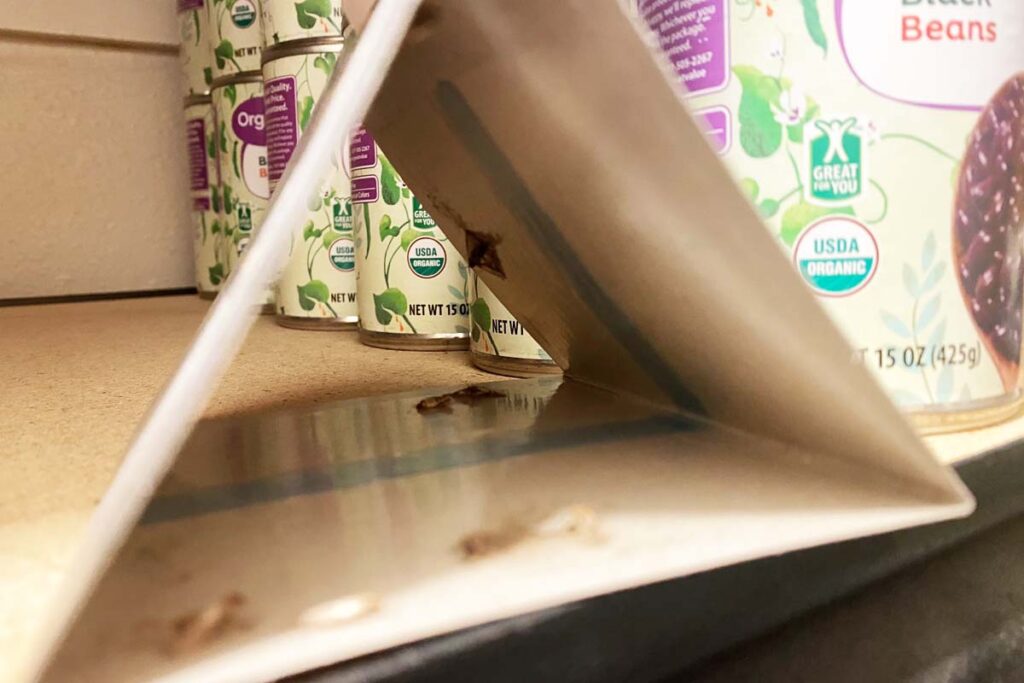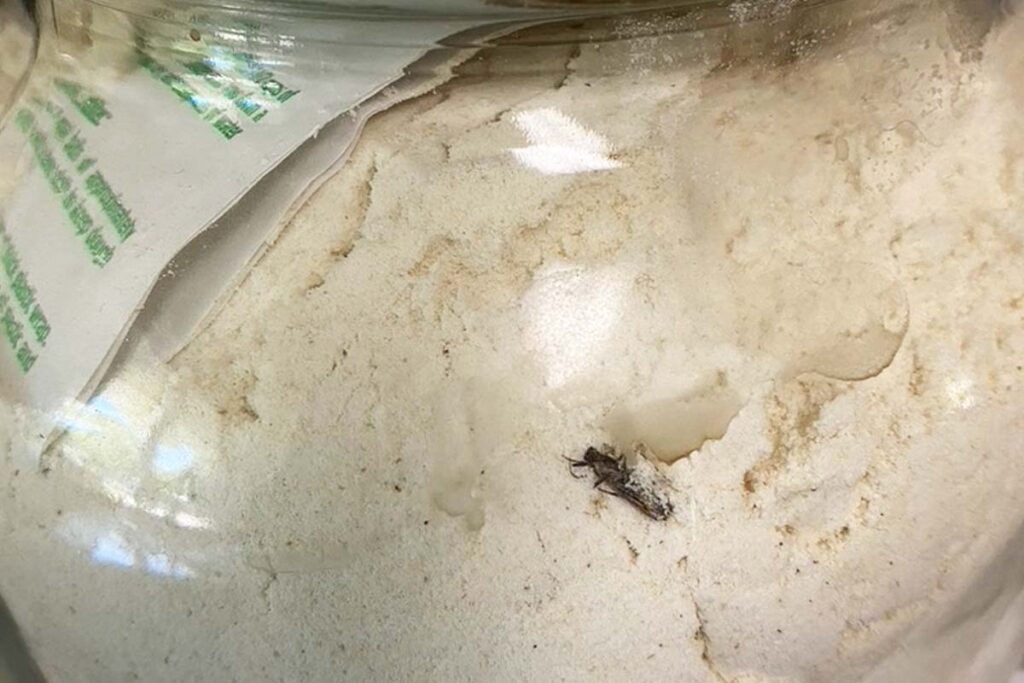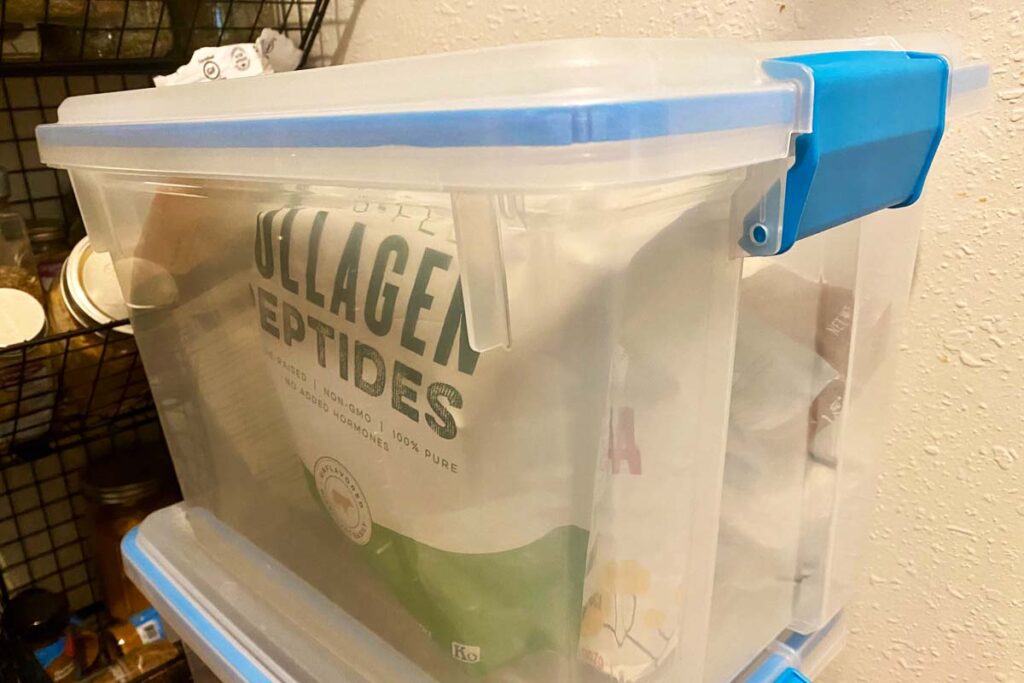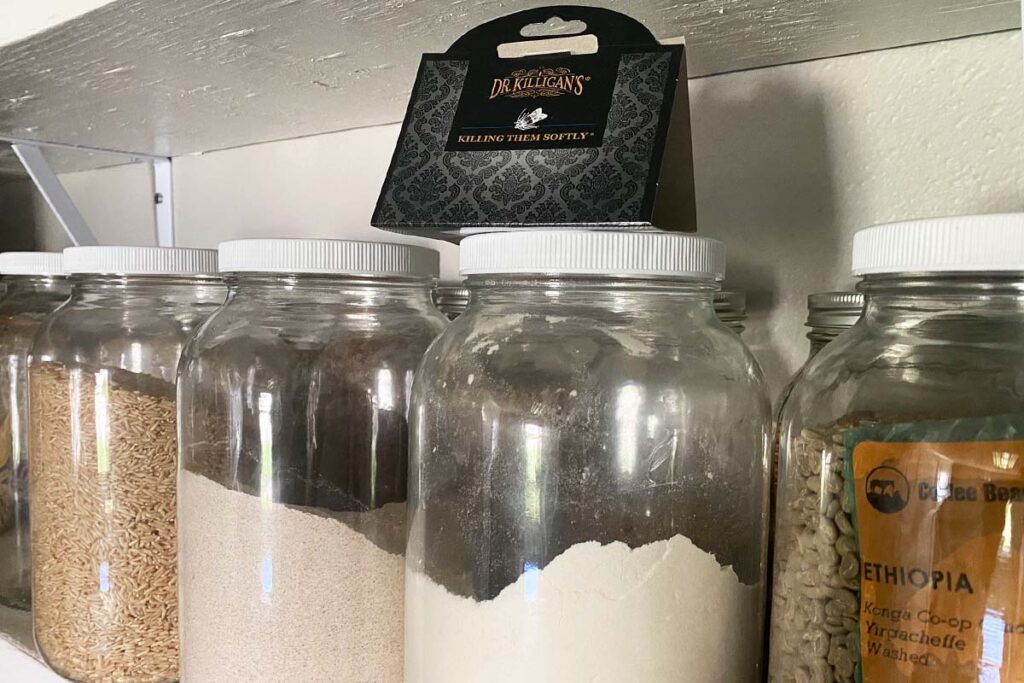It all started when I noticed moths randomly around my house. They were about a 1/4 to a 1/2 inch long and very easy to smoosh.
I couldn’t figure out where they were coming from and didn’t think too much of it until one day I went to grab a bag of pecans from my pantry and the bag was FULL of them.
That led to more and more and more discoveries … eventually finding an entire 25-pound bag of unused sprouted wheat berries serving as a massive breeding ground. I had never heard of pantry moths until then and never thought pantry moths could be such a nuisance, but they turned out to be relentless foes in my year-long battle to protect my whole grains AND my entire pantry from their invasion.
Honestly, I probably lost over $500 of food from these guys and it’s been so difficult to get rid of them.
These common household pests, known as pantry moths or Indian meal moths, can quickly infest a variety of food items stored in our kitchens. I learned that they are particularly fond of whole grains and I was determined to find a way to keep these tiny creatures at bay.
Over the course of the year, I kept experimenting with different methods to keep pantry moths out of my whole grains. It was a challenging endeavor, but I’ve finally managed to get a grip on the situation, so now I want to share my experience and what I’ve learned along the way.
Identifying pantry moths
Physical characteristics
Pantry moths, also known as Plodia interpunctella, are small flying insects that have a tan, brown, or gray color. Their wings are typically around half an inch wide, and they have a zigzag flying pattern. As I’ve observed, they have two distinct pairs of antennas that are thin and elongated.
Life cycle
The life cycle of a pantry moth begins as an egg. Female adult moths lay hundreds of eggs directly on or near potential food sources, like grains, seeds, nuts, and other pantry items. Once these eggs hatch, larvae emerge and start feeding on the surrounding food. If left undisturbed, they can cause substantial damage to stored items.
After feeding and growing for some time, the larvae will spin cocoons to transform into pupae. This stage is where they’ll develop into adult moths, ready to lay more eggs and repeat the cycle. The whole process from egg to adult moth can take anywhere from a few weeks to several months, depending on environmental conditions.
Signs of infestation
In my experience, there are two common signs of pantry moth infestation:
- Webbing: If you see tiny silk-like webbing near the edges of food containers, it’s a sign of larval activity.
- Adult moths around your house: If I see small moths fluttering around my kitchen, pantry, or food storage areas, it’s a warning sign I might have an infestation somewhere.
Although pantry moths and clothes moths may appear similar, they have different food preferences and habits. While pantry moths are attracted to grains and other food items, clothes moths prefer fabrics like wool or silk. So understanding each moth’s characteristics will help me ensure I’m taking the right steps to eliminate them.
How pantry moths infest whole grains
Let me share with you how pantry moths infest whole grains and what you can do to prevent it.
Common sources of infestation
Believe it or not, pantry moths can come straight from the grocery store. I’ve found them in all sorts of products like rice, cereals, dried beans, pasta, and even nuts, spices, and dried fruits. Their eggs are not always visible, but they can hatch into larvae, wreaking havoc on your pantry.
The adult females lay hundreds of eggs directly on or near potential food sources. These eggs then hatch into larvae (tiny caterpillars), which are responsible for the actual damage to the grains and other food items.
A friend also purchased raw pecans from the same grocery store I did and she also experienced pantry months, so I’m pretty sure mine came from the pecans.
Spreading and contamination
Let me explain how easy it is for pantry moths to spread. The larvae can crawl through different types of packaging, like cans, plastic, and cardboard, allowing them to infest various pantry items with ease.
This is what shocked me the most: Plastic packaging, even the thicker kind, is not a deterrent.
Once inside, they can contaminate your grains, cereals, flour, rice, corn, beans, dried fruit, nuts, spices, and herbs by feeding and leaving behind webbing and waste. In fact, webbing is often the first visible sign of a growing pantry moth problem, which can appear in the corners of pantries and cupboards, as well as in and on bags of dried goods.

To combat these pests, I’ve learned to pay close attention to the packaging of the food items, store grains and other foods in airtight containers, and clean my pantry regularly.
Don’t underestimate these pesky pantry moths, as they can quickly infest and ruin your whole grains and other food items. Being mindful of the sources of infestation and taking appropriate preventive measures can help you protect your pantry and its contents from these persistent pests.
Getting rid of pantry months
As someone who has experienced a year-long battle with pantry moths, here is what worked for me:
Step 1: Clean and remove infested items
The first thing I did was to thoroughly inspect my pantry and remove any infested items. Look for larvae, webbing, and holes in packaging. Pantry pests like Indian meal moths can get into almost anything, so be sure to check rice, beans, pasta, cereals, nuts, seeds, dried fruits, spices, and even pet food. Dispose of any infested items in a sealed plastic bag, and then vacuum the entire pantry, including shelves, walls, ceilings, and floors, paying special attention to corners and crevices.
I found webbing and moths on walls, in corners, on the bottom of packaging, and even inside a jar of flour that had a lid with a very tiny crack.

After vacuuming, I wiped down all surfaces with soapy water to remove any remaining larvae, pupa, cocoons, or webbing. Make sure to clean cabinet hinges, knobs, and other hard-to-reach areas. Let everything dry completely before restocking the pantry.
Step 2: Move everything to proper storage
One essential step in preventing pantry moth infestations is to store whole grains and dried foods like cereals, dried fruit, seeds, nuts, dog food, birdseed, herbs, and chocolate in airtight containers. I found that using high-quality plastic or glass containers with tight-fitting lids significantly reduced the chances of an infestation.
I ended up moving EVERYTHING that I brought new into large plastic tubs that had a seal and then storing smaller items in canisters I found at Walmart (I got a bunch of these Better Homes & Gardens Canisters).

I also make sure to regularly inspect cans, bags, and boxes for any signs of pantry moths before bringing them into my kitchen.
Step 3: Up your cleaning practices
Maintaining a clean kitchen and pantry area is crucial in deterring pantry moths. I make a habit of vacuuming my pantry shelves and kitchen cupboards, removing any crumbs and webbing left by moths. I also clean my shelves with vinegar, as pantry moths dislike the smell. To further protect my whole grains, I’ve added bay leaves around the pantry, as their scent helps repel pantry moths.
When I discover a cocoon or moth webbing, I immediately discard the infested item and clean the surrounding area thoroughly. I’ve also found it helpful to periodically remove all food from my pantry and wipe down shelf liners with a vinegar solution to eliminate moth eggs and larvae.
Honestly, I had to take everything out of my pantry, inspect everything, clean it all, and put it back four times. It was a huge pain but I slowly started to find where they were hatching out new moths.
Step 4: Use pheromone traps
To keep pantry moth infestations from getting out of hand, I set up pheromone traps throughout my kitchen and pantry. These traps lure adult pantry moths with synthetic pheromones, trapping them and preventing them from laying eggs.
This was a GAME CHANGER. We kept having outbreak after outbreak and it wasn’t until I added pheromone traps that I saw us finally turn the tide in our favor.
Here are the ones I found on Amazon: Dr. Killigan’s Pantry Moth Traps

In addition to using pheromone traps, I regularly monitor my pantry and kitchen to detect any signs of pantry moths. This involves checking food sources for moth activity, watching for larvae or adult moths, and looking for telltale webbing around my stored grains. With proper storage, consistent cleaning practices, and vigilant monitoring, I’ve been successful in preventing pantry moth infestations and safeguarding my whole grains.
Step 5: Freeze new food that comes into your home
Most foods can be safely frozen. Nuts, grains, flours … Make it a habit of giving it a 3-day freeze bath in your freezer, then put them in your pantry like normal.
This will make sure any moths that come from the grocery store are killed before they can be unleashed into your home.
Frequently asked questions
How do pantry moths get into sealed bags?
Pantry moths can be quite sneaky, finding their way into sealed bags through microscopic holes. They can also hitch a ride on new packages of food we bring home from the store. I’ve even encountered them in factory-sealed bags, as they may have entered during the manufacturing process. It’s important to inspect every package for signs of infestation and store whole grains properly to maintain their quality longer and keep pests at bay.
If it’s not thick thick thick plastic (think plastic storage tubs you use for Christmas decoration storage) or glass, assume they can get through it.
Can exterminators effectively eliminate pantry moths?
Yes, exterminators can help eliminate pantry moths; however, it’s essential to take additional steps to avoid re-infestation. I’ve found that simple measures like cleaning and sealing pantry shelves, throwing out infested food, and using airtight containers for grain storage can significantly reduce the likelihood of pantry moths returning. Ultimately, a combination of professional extermination and personal vigilance is the most effective approach.
What are proven methods for permanently eradicating pantry moths?
A combination of cleaning and preventative measures is the most effective way to permanently eradicate pantry moths. This includes thoroughly cleaning pantry shelves, investing in airtight containers, and discarding any infested food. I also recommend using pantry moth traps to monitor their presence and catch any remaining moths. Pheromone traps were the game changer for us.
How quickly can one get rid of a pantry moth infestation?
The time it takes to get rid of a pantry moth infestation can vary depending on the severity of the problem and the methods used. I’ve experienced improvement in just a few days after implementing a combination of cleaning, storage, and trapping methods. However, it can take longer for some infestations, and it’s essential to stay vigilant to avoid re-infestation in the future. It took us a FULL YEAR of dealing with them to get rid of them for good.
Do pantry moths have any negative effects on human health?
Although pantry moths can be quite a nuisance, they do not pose a direct threat to human health. They can, however, contaminate whole grains and other stored foods, which should be discarded if they show signs of infestation. It’s important to deal with pantry moths promptly to prevent further food waste and maintain a clean, healthy kitchen.
The only real detriment to my health was the frustration of having to throw out about $500 dollars of food!
What measures can be taken to protect grains from pantry moths?
To protect grains from pantry moths, I recommend using airtight containers made from glass or heavy-duty plastic to store them. Keep your pantry clean and well-organized, inspecting new packages of food for signs of infestation before putting them away. Regularly cleaning your pantry and using moth traps as a monitoring tool can also help reduce the chances of pantry moth infestation.








